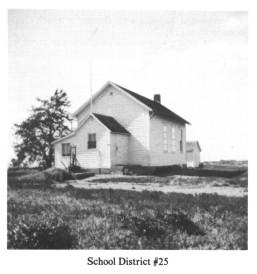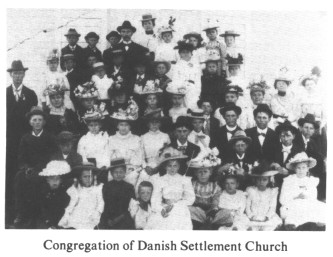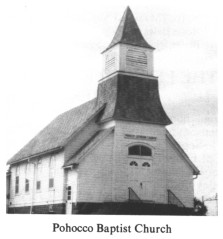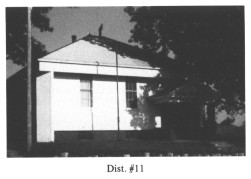 |
POHOCCO PRECINCT |
|
along with her husband Rev. Wm. Robbins. Rev. Herman Wedel was ordained pastor by the church here Oct. 10, 1915. He liked being with the youth and spent much of his spare time in evenings playing baseball with them. After his wife's death he returned to Rochester, New York to further his seminary training. During Rev. Emil Otto's ministry, 1917-1919, the church records were now kept in the American language for the first time. In 1933 the older records were translated from German to American language, by Rev. E.F. Krueger, who was at Sioux Falls College, Sioux Falls, South Dakota and his father-in-law, Rev. A.L. Tilgner, a retired German Baptist minister. In 1922 Rev. D.L. Fraser became pastor of both Pohocco and Mead Emmanuel Churches until 1930. In 1928 the parsonage was sold and the money was used to put a basement under Pohocco Church and to remodel the building. Rev. William Overturf became pastor in the fall of 1931. He had a very successful Vacation Bible School in the summer of 1932. Rev. F.K. Allen served 1933-1935. New oak pews were purchased and installed and much work was done. Rev. E.E. Niederhuth 1936-1941, further remodeled the building, installed a furnace, kitchen equipment, electric lights, and other improvements. In 1943 Rev. Harold Sweezey and Rev. R.M. Bailey came to serve. The cemetery is all that is left there now, as an arsonist burned the church down to the ground in 1960. ESTINA CATHOLIC CHURCHIn the 1870's a number of Catholic families settled in the Pohocco and Estina (which was later called Leshara) Precincts. As Mission priests came through the area they were given food and lodging and they offered Mass in the homes. In 1877 Father Langernon built churches in Elkhorn and Fremont. A priest lived in Colon by then and would come periodically to this area; otherwise the people went to Mass in Fremont. The long ride meant starting early in the morning, leaving Fremont right after Mass as they had no money to purchase food for themselves or their horses. Getting across the river and up the bluffs might take quite awhile; they would even arrive home late sometimes. In 1887 the Conrad, Carey, Kinney, Miller, McDonald, Hannon Boyle, McCoy, Feist, Goliglee, Lammel, Schnetzer, Nau, White, and Feurenstein families decided to build a church. Julia White deeded an acre of land from the northeast corner of her farm for this church. Building was completed in 1888 -- the church was named "Church of The Seven Dolors" or Estina Church. In 1924, for unknown reasons, it burned. In 1925 it was replaced by a new church called "The Church of the Little Flower of Jesus." Father Wattell had it built as a replica of a chapel he had seen in the French countryside. In 1960, fire caused by an arsonist burned the church to the ground and was not replaced. The church members were assigned to Cedar Bluffs or Mead parishes. The cemetery is all that remains in that spot now.
DISTRICT #11 PLATTEVILLE | ||
 | ||
| School District #25 |
The school was a focal point of the community as well as a place of learning. "Literary" was held every Friday night and everyone in the community came. These events were diversified, never having the same kind of program two weeks in succession. There were games, spelling bees, ciphering, music, recitals, book reviews, and debates. They studied plays and acted them out as well as concerts put together by the people living in the community.
Exciting evenings were the traveling shows, Punch and Judy, and lecturers stopping for a performance. Much loved were the magic lantern shows. They used to stop overnight and put on a performance with the magic lantern, showing the far away places they were telling about.
There were many happy days at the little school, but also some sad ones. Quite a few long processions were made by the teacher and pupils to the little Pioneer Cemetery to bury one of their fellow classmates.
On Sundays, Sunday School was held in the school house. Sometimes a missionary came and conducted services. He might even have a small organ in his buckboard to be used during song service.
At Christmas time a huge cedar tree was dragged in and set upon a temporary stage in the front of the room. Sacks of candy, nuts, and presents for all were hung on the beautiful, candle-lit tree. Santa came on Christmas Eve and many times his whiskers narrowly escaped scorching as he would get too close to the lighted candles.
In 1880 the little school was moved across the road, to the north, where it remained until 1962 when it was permanently closed. Its original appearance changed over the years with remodeling and renovations. The building is no longer there and the only thing left as a reminder of its existence are the memories handed down by those who attended school there.
Compiled from stories written by descendants of Enoch Chritton. Submitted by Terilee Freeman Roberts.
OTOE CREEK SCHOOL --
DIST. 46
The first day I went to school at District 46 in Saunders County to the Otoe Creek School I must have been the utmost in fashion. High top shoes, black sateen bloomers and an apron over my dress must have been less than appealing. But I was not alone in my mode of attire. Pigtails were also quite popular, although I do remember having my hair "bobbed," and sometimes curled with the curling iron that fit into the lamp chimney to make it hot for curling.
We lived in the center of the section and my road to school was along the fence lines across the section, and a creek to meet with the Andrew Christensen children with whom I walked the rest of the way to school. All children walked to school in those days regardless of the distance.
Otoe Creek was always blessed with a large group of children, all to be in one room with one teacher. Double seats meant two in one seat which sometimes was a distraction and other times just plain fun depending on your partner. Each desk had a built-in ink well. Ink had to be used for penmanship class. To
page 105
| Back | Contents | Next |
The Saunders County NEGenWeb Project


